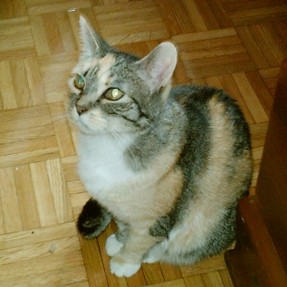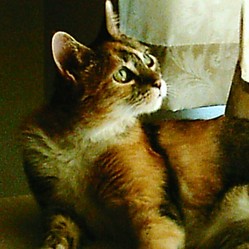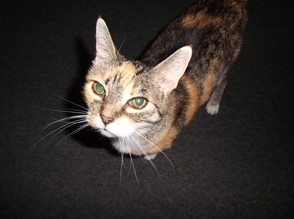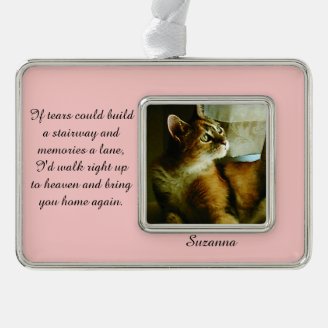I met Suzanna in April, 2001 when she ran up to me as I got out of my car in the driveway of my home. She was so skinny I could see her ribs and spine. She had bald spots all over her tiny body and open wounds that were dripping blood. We went directly to the vet, where it was determined that she was about 3 months old, and after an overnight stay at the vet, Strawberry Ling and I had a new roommate. (Strawberry wasn't happy about that at all, but that's a story for another time.)
I noticed right away that Suzanna wasn't having daily bowel movements, it was just about every other day. It took almost two months for her to get healthy and fit. She gained weight, her hair grew back, her wounds healed and she was happy and frisky. The bowel movement issue was still the same, about every other day.
Fast forward eleven years to March of 2012, that's when the bowel issue became a real problem.

Megacolon in Cats
by candy47
Not just a simple case of constipation. My cat was diagnosed with 'megacolon' it's an enlarged colon and must be treated by a veterinarian.
This article is an account of our personal experience and is not a substitute for advice or treatment by a veterinarian.
I Thought She Was Constipated
March 2012 Suzanna hadn't 'pooped' for 2 full days. I put a little bit of mineral oil in her food as a stool softener. I had given her mineral oil many times over the years, with positive results. I waited another day but still nothing. She stopped eating. She would lick up all the gravy around the meat in her dish, but wasn't actually eating anything. It seemed like a case of constipation, so I took her to the vet where she was given a comprehensive physical exam, an enema and a prescription for Lactulose (a stool softener.) The Lactulose did soften the stool as intended, but when the prescription ran out, she didn't return to her 'regular' routine of every other day.
Symptoms and Tests
The beginning of June 2012, Suzanna hasn’t had a bowel movement for 3 days. She’s been taking Lactulose as prescribed and an occasional dose of mineral oil, but she’s blocked. My plan was to take her to the vet when I got home from work. I went home at noon just to check on her and what I saw was a horror. My house looked like a crime scene. There was bloody feces everywhere…on the floor, the furniture, the bed. I raced around looking for her because we were going to the vet NOW! Never mind going back to work. Suzanna walked out from the closet where she was hiding and vomited blood…all blood.This visit to the vet required an overnight stay, 2 enemas, x-rays, a sedative for the enemas, a pain suppressor, a blood test, antibiotics, MiraLAX and Cisapride. The presence of blood was a result of irritation to the intestines due to the blockage of fecal matter. After the enemas were performed, the bleeding stopped.Suzanna was diagnosed with having an enlarged colon, also known as megacolon.
Signs of Megacolon
These are the signs that Suzanna displayed
-
Infrequent bowel movements
-
Straining when trying to 'go'
-
Very hard and dry stools
-
Stools are larger in diameter than usual
-
Several trips to the litter box with no results
Exercise and Rest
 |
| Go Pet Club Cat Tree Furniture Beige |
Megacolon
How we treated it
What Is Megacolon?
The colon is a cylindrical organ, continuous with the rectum, that is stimulated by nerves from the spinal cord to push fecal matter from the body. If the nerves do not function properly, the wall of the colon will not contract, enlarging the diameter of the colon and compromising it’s ability to push. Fecal matter will accumulate in the colon causing severe constipation or obstipation. (obstipation is an extreme form of constipation that does not respond to common treatment of constipation.) This enlargement of the colon is known as megacolon.
What Causes Megacolon?
An injury to the spinal cord can cause megacolon as well as tumors, hairballs and foreign objects. In many cases, as with Suzanna, the cause could not be determined. When the cause of the disease cannot be determined, it is known as idiopathic megacolon. The disease usually occurs in older cats.
How Is Megacolon Treated?
Surgery to remove the unresponsive section of the colon is an option but not always necessary…at least not at the onset of the condition.
A manageable approach involves a high-fiber diet, stool softeners and a colon wall stimulant. Suzanna is on the manageable approach regimen. We changed her diet and she will take medicine for the rest of her life, unless the condition worsens, then we will resort to surgery.
Suzanna’s medication is MiraLAX (over-the-counter stool softener) twice a day and Cisapride (colon wall stimulant) twice a day. Suzanna will be taking both of these for the rest of her life.
Cisapride
Cisapride is available by prescription only from a veterinarian and must be given in precise dosages and at precise times. The purpose of Cisapride is to stimulate the wall of the colon so that the muscles will contract and push fecal matter out of your cat's body avoiding constipation.
Pet Carrier For Travel to the Vet, a Bed for a Good Night's Sleep and Grooming After a Very Trying Day!
A Veterinarian Explains Megacolon
One minute video - it's worth watching
Sad News
We were managing Suzanna's megacolon with daily medication, but then in December of 2013 she was diagnosed with cancer. Suzanna passed away December 30, 2013. My  heart is broken.
heart is broken.
If Tears Could Build a Stairway....
In memory of your beloved pet
This is my cat Suzanna, but you can insert a picture of your beloved pet instead. The name can be changed and so can the background color. This ornament is completely customizable.
You might also like
My Wizzography or Confessions of a Cat LadyWelcome to my Wizzography! This is where I get to tell you a little about my...
Animals in the YardA glimpse of the Arizona desert wildlife and not so wild life, that I see fro...












 Benefits of Bee Propolison 10/19/2016
Benefits of Bee Propolison 10/19/2016
 Legend of the Dreamcatcheron 10/15/2016
Legend of the Dreamcatcheron 10/15/2016
 The Pioneer Woman - From Blog to TV Serieson 09/05/2016
The Pioneer Woman - From Blog to TV Serieson 09/05/2016
 Coloring Books for Grown-upson 08/29/2016
Coloring Books for Grown-upson 08/29/2016



Please Leave a Comment or Suggestion
That makes sense JOEI. Something new might be too disruptive for her.
I never heard of Colon Rescue Drops. Keep us posted on that please!
I know what you mean JOEI JOSLYN. We had setbacks with Suzanna's megacolon too. We changed medication but always managed to keep it in check. I never gave up.
Thank you Candy47, everytime I think Choo is doing good we have a set back, but I will not give up on her.
Thank you JOEI JOSLYN. I hope you can continue managing this condition for your precious Choo.
My cat Choo has this condition, was doing well on Cisapride and Miralax since 2013, now back up to the vets. Lactulose was ruining her teeth. So sorry for the loss of your little one.
Thank you blackspanielgallery
I had no idea of this condition, and sorry to hear your cat passed.
Losing a pet is so difficult, they're family. I've seen a few familiar faces here from Squidoo, we're all still learning the ropes here on Wizz, but I like it!
So sorry you lost her. Nice to see a familiar face here (I came from Squidoo). I just published my first article here. The learning curve is not fun! I learned a lot from your article.